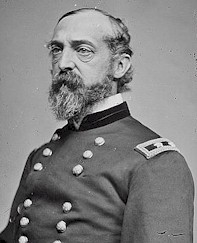July 02, 2006
Gratuitous Gettysburg Posting

Gen. George Gordon Meade, commander of the Army of the Potomac. Meade did not want to fight at Gettysburg, instead favoring a pre-selected defensive line along Pipe Creek some miles away to the southeast. However, once the battle was engaged, Meade had the sense to listen to his commanders and hold upon the heights of Cemetary Ridge. For this, he deserves considerable credit.
I've been trying to think of something to say to mark this, the anniversary of the Battle of Gettysburg (fought June 1 through June 3 July 1 through July 3, 1863) [Ed - no more cocktail time blogging for you], but for some reason this year all I can think about is this: If you're planning to commemorate the battle by popping in your DVD of the movie Gettysburg, keep in mind that this movie, while fine as far as it goes, does not tell the whole story of the battle.
For some reason, this is rankling on me this year.
Now, Michael Shaara, in his preface to The Killer Angels (on which the movie was based), made it quite clear that he was not, in fact, writing a book about the battle of Gettysburg, but rather that he was writing about some of the men who took part in that battle. I think the movie does its audience some discredit by not making this same point.
So, for instance, the film does a pretty good job of detailing the tactical situation at the beginning of the first day (June 1), when Buford, recognizing the advantages of the ground he held, decided to make a stand with his Federal cavalry in order to give John Reynolds' First Corp infantry time to come up and engage. But the movie gets rather vague after the point where Reynolds is shot and killed, speaking hazily of a general Union retreat. IMHO, this sells short the gallant efforts of the First and Eleventh Corps to hold back the superior forces of Hill, Ewell and Early. In fact, the battle lasted all day and involved tenacious fighing on McPherson Ridge, Seminary Ridge and Oak Hill, and concerned not just Buford and Reynolds, but also men like Wadsworth, Shurz, Barlow, Abner Doubleday (yes, that one) and many others.
Similarly, one might gather from the movie that Col. Joshua Chamberlain's successful defense of Little Round Top was the end of the fighting on July 2. This is far from the case. Although the Devil's Den, the Wheat Field and the Peach Orchard - all scenes of incredible carnage - get brief mention, the average viewer would not know that the attack on Chamberlain's position at the southern end of the Union line was just the first part of Lee's assault and that the battle echeloned north all day and into the evening. I think this does great disservice to, for example, Col. William Colvin and the 1st Minnesota, who stopped a Confederate breakthrough on Cemetary Ridge at the cost of 82 percent casualties. And indeed, no mention whatsoever is made of the fighting on Culp's Hill and Cemetary Hill, the extreme northern ends of the Federal line, at the end of the second day and on into the morning of July 3.
Finally, the movie mischaracterizes Pickett's Charge on July 3 in two important ways. First, it buys into the view of that charge as being a Virginia affair. In fact, two of the three Confederate divisions involved in the charge - those of Johnson Pettigrew and Isaac Trimble - were largely composed of North Carolingians. And indeed, there is considerable evidence that North Carolina regiments got farther forward than any units from Virginia. Pickett got all the glory because the Richmond Press was heavily represented at the battle. This fact still drives North Carolingians batty, even today.
Second, for dramatic purposes, I suppose, the movie hints that the charge came close to working, that the Union was this far from breaking. Well, the truth of the matter is that it wasn't that close at all. Lee was throwing a Hail Mary and he knew it. And while the Confederate forces did actually make it up to the Union positions in one or two places, they simply did not have the support necessary to exploit such advances. The Union Army, on the other hand, was perfectly situated to reenforce itself anywhere along the line as needed and did so.
So there you have it. If you're interested, I can recommend two books out of my own library about this momentous battle. The first is Glenn Tucker's High Tide at Gettysburg, which gives an excellent overall picture, while at the same time offering some extremely interesting intimate details. (For example, the 15th Alabama under Col. Oates, which attacked Chamberlain's position on Little Round Top, was forced to go into battle after a forced march with no water because their canteen detail had been captured by Yankees. What impact might this have had on their fighting effectiveness?)
The other book is Earl J. Hess's Pickett's Charge - The Last Attack at Gettysburg. This is a very dry and academic history, methodically laying out the positions of the various infantry and artillery units on both sides during the course of the attack on July 3. From this data, it is clear Lee's plan never had a realistic chance of succeeding.
Posted by Robert at July 2, 2006 06:48 PM | TrackBackNot to mention that Strong Vincent and the 83rd PA received scant mention in this movie.
(I'm rather biased on that, but you already knew that.)
Posted by: GroovyVic at July 3, 2006 05:55 AMBut I'm thinking we should have a blogmeet in G'burg.
Posted by: GroovyVic at July 3, 2006 06:13 AMOoooooooh........
Posted by: Robbo the LB at July 3, 2006 08:08 AMJune 1 through June 3? Maybe in your universe, but mine has the battle taking place July 1 - 3.
Posted by: rbj at July 3, 2006 11:18 AMEven Lee's Generals knew Picketts's Charge had no chance against the rifles of the day. The attack was strategy from 30 years earlier, before highly accurate weapons were on the battlefield in large numbers.
Cover was altogether on the side of the Union troops too.
Makes you wonder if Lee had begun to believe his own PR?
Posted by: Zendo Deb at July 3, 2006 08:14 PM

 Image courtesy of the lovely and talented
Image courtesy of the lovely and talented 